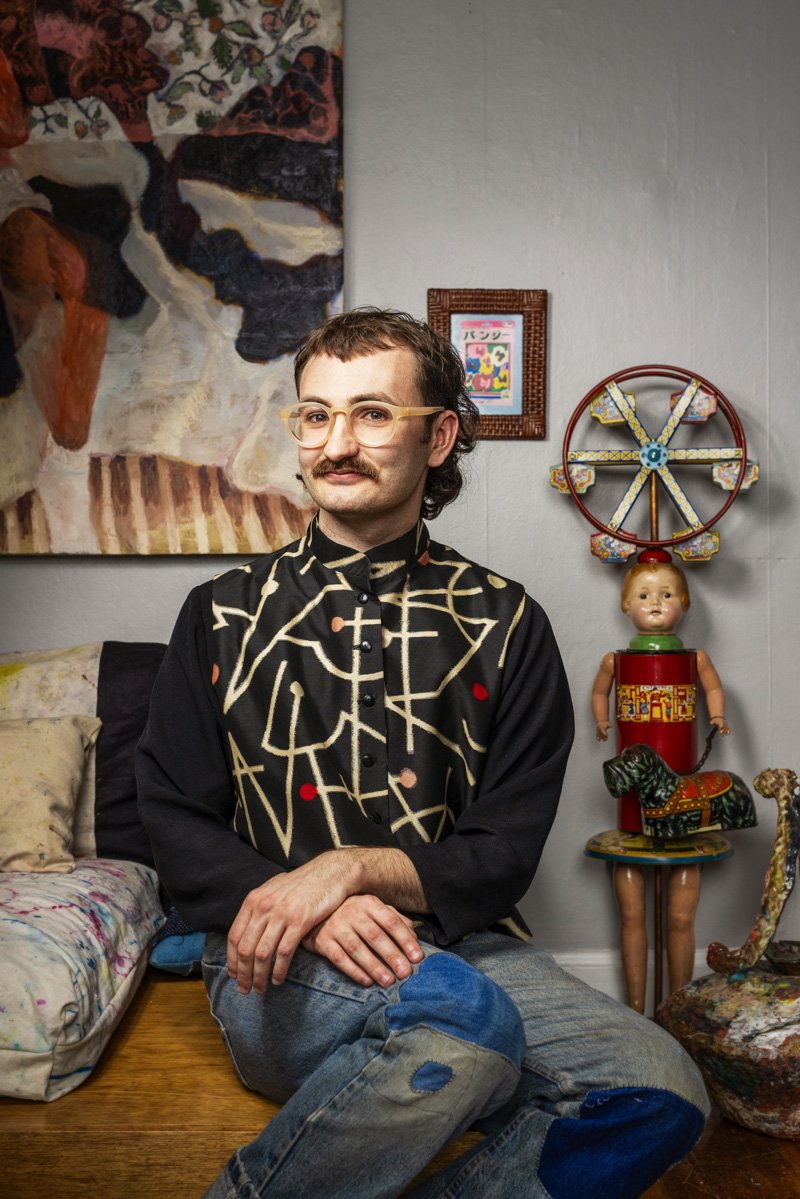(photo by Jim Barcus)
Queering the quilt tradition
The garments we put on our bodies and fabrics we drape over ourselves tell stories. From grease, blood and rust to rips, tears and punctures, materials have history. They show their wear and purpose through the scars and markings that build up through the years. They send secret messages of sexuality to those who know the codes. They can be functional indicators of industry, as in the ubiquitous white striping down denim railroad overalls. Quilter Nathan Ford lives within these idiosyncrasies to produce work of both the current cultural moment and deeply rooted in history. “All of us use materials in a different way,” Ford said, “and especially when I’m working with clothes, I like seeing the holes, and those points of impact that really show this was well-loved.”
Hailing from the Rust Belt of Columbus, Ohio, Ford wound up in Kansas City to attend the Kansas City Art Institute as a fiber student. The pandemic pushed him into quilting almost as a necessity because he had plentiful pieces of fabric, a sewing machine and endless free hours during lockdown. It was during these moments that he began to stitch his family history and queer identity into quilts.
Ford, who calls himself a “soft historian” for his focus on historical fabrics and soft materials, found knowledge around the rise and fall of the automotive industry in the Rust Belt lacking in Kansas City. What was deeply ingrained in his upbringing was relatively unknown here. As a way to connect with his own history and raise awareness, he began to approach that time period through materials, sourcing and collecting traditional American workwear, depression-era feed sacks and other materials that tell a story through the ways they were touched. Ford loves stains and sun marks because they make an object human. He elaborates, “There’s the hard fact — I can research (that) this brand was from this time and was used in this way. But I also really like the personal relationships we have with the objects.” Some of these objects came from his family, including a stained 1930s tablecloth from his great-grandmother.
Craig Auge, multimedia artist and curator, met Ford during his time at KCAI. “It was immediately clear from his inventive, progressive thesis work, imbued with deep, multilayered concepts around queerness, labor, and family lineage, alongside inventive patterns and designs, that he would be going very far in his artistic career,” Auge said. “His quilts contain layers upon layers of meaningful history while confidently propelling us into the future of quilting-making.”
Ford masterfully stitches themes of queerness throughout his quilts, often through signifiers of cruising, the practice of discreetly signaling queerness while in search of a sexual partner. Historically, this was done with different colored hankies, carabiners, earrings and even form-fitting Levis. As he explains his draw toward more subtle signifiers of queerness, “I’m tired of the rainbow flag motif. It’s been done. Let’s think about other ways in which we can get to the root of things and question how sexuality is presented without it being so direct.”

Part of this signifier for Ford is including quirks and wonkiness in his quilts. “So much about quilt history is about repetition of tradition. So a lot of times in my work, I’ll take a traditional quilt block and make it a little bit uneven or I’ll use unconventional materials,” he said. “I see that as a way of directly queering it — of taking this tradition and saying, ‘Well, maybe there’s something else we can do with it.’”
Ford’s most recent show with artist Bernadette Negrete, “Lovetoy,” at Holsum Gallery, offered a commentary on the often-frustrating quest for sex, love and affection. “It’s the intersection of being horny, longing, being sad and then also being so in love and so infatuated,” says Ford. In “Portrait of Us (October),” Ford stitched Calvin Klein underwear into a small, wonky quilt with his own used dental floss. “Nathan’s work is the perfect mixture of raunchy and sweet,” says Negrete. “His attention to detail, craft, and medium creates an intense intimacy. Nathan does an incredible job at making work that is funny, sincere, and absolutely beautiful. It’s been an absolute dream to collaborate with him on our show.”
Ford has the unique ability to connect the present to the past with historical materials and techniques viewed through a current lens. Each move he makes is done with care, intentionality and deep thinking. His aesthetic and expression are certainly some things to keep an eye on. Auge elaborates, “It is a joy to be with his work, up-close and personal, to fully experience his singular aesthetic sensibility and material sensitivity. He continues to be driven, and his work ethic and passion inspire and motivate me as an artist.”






